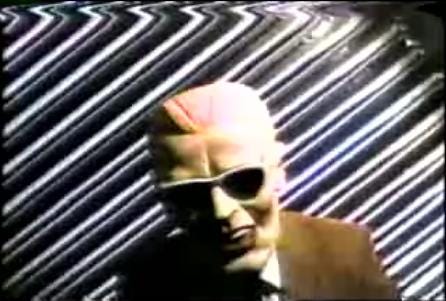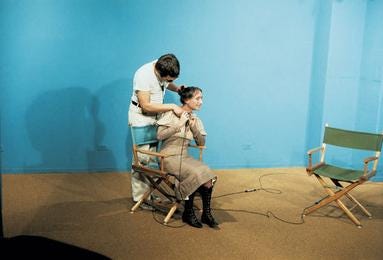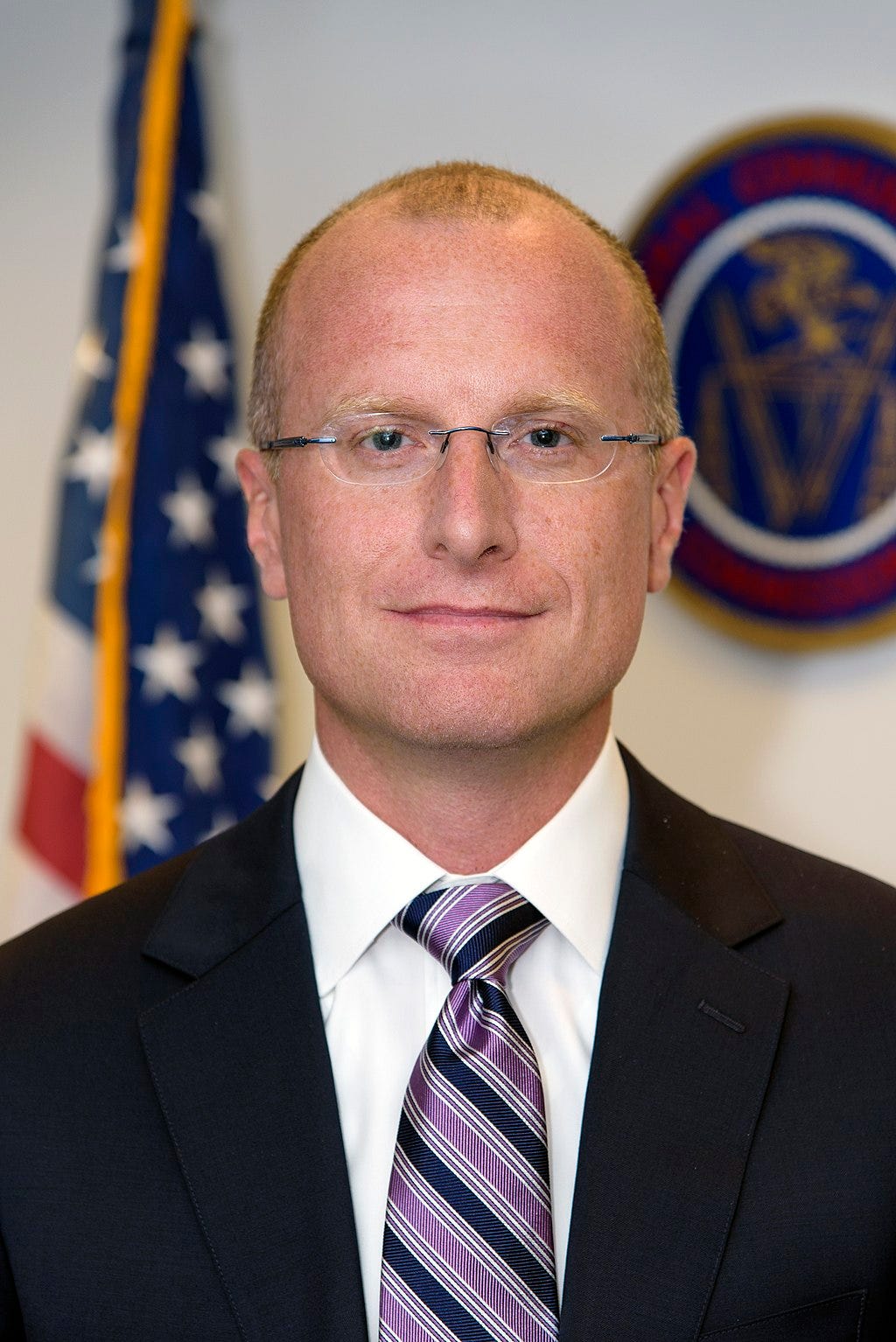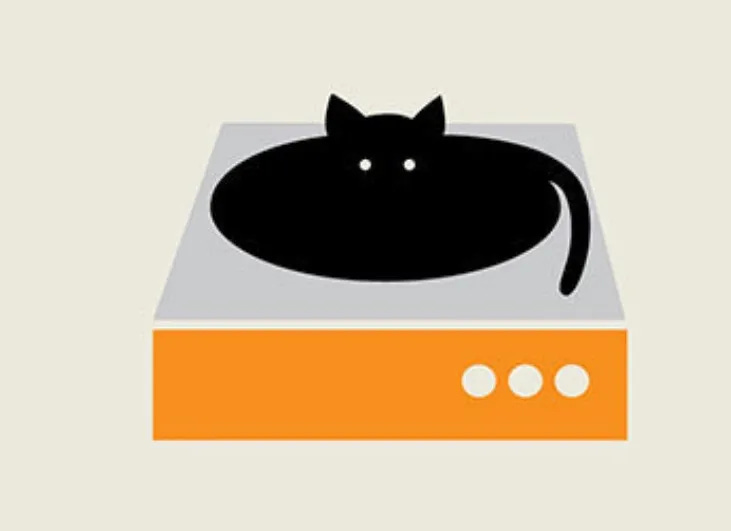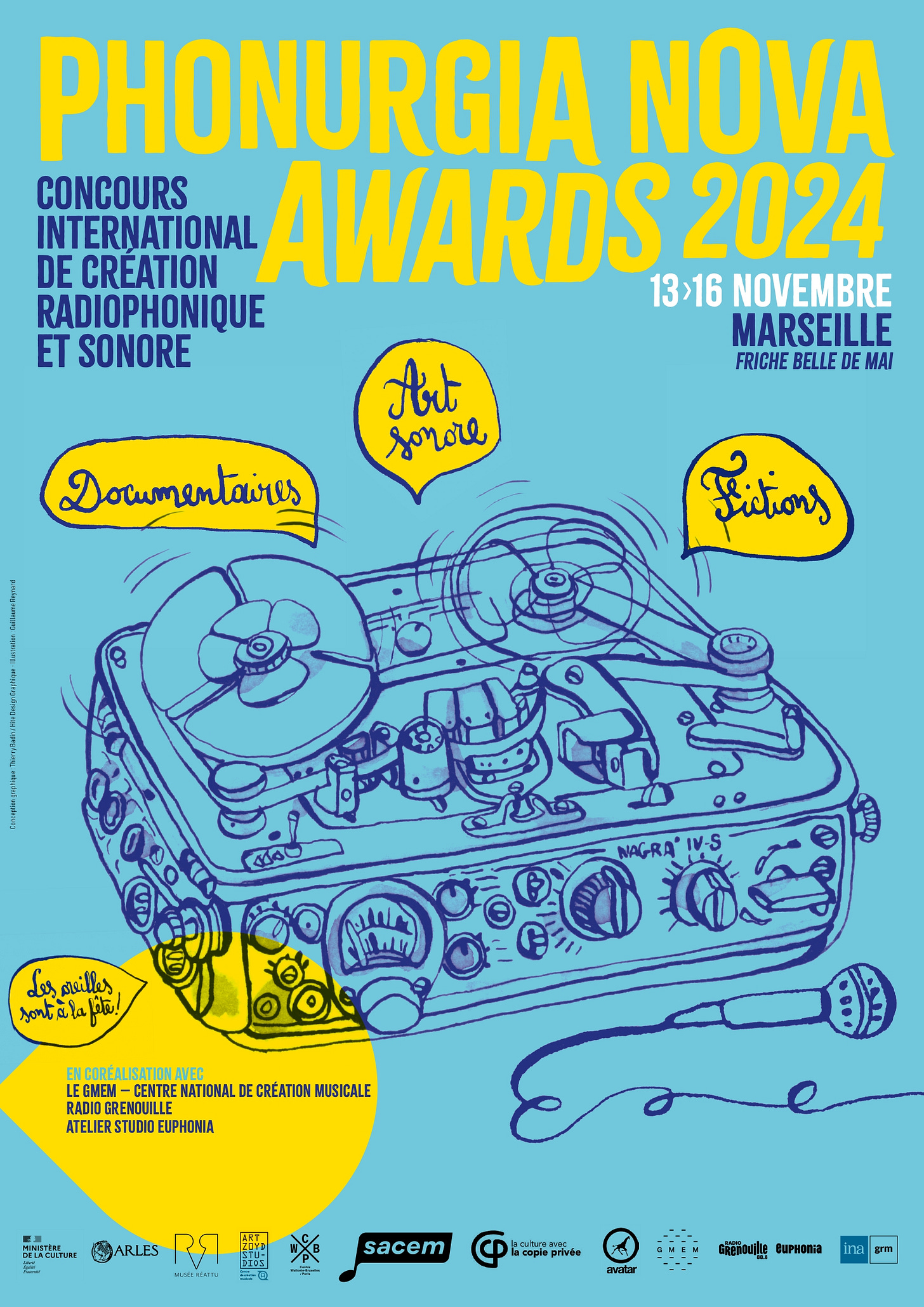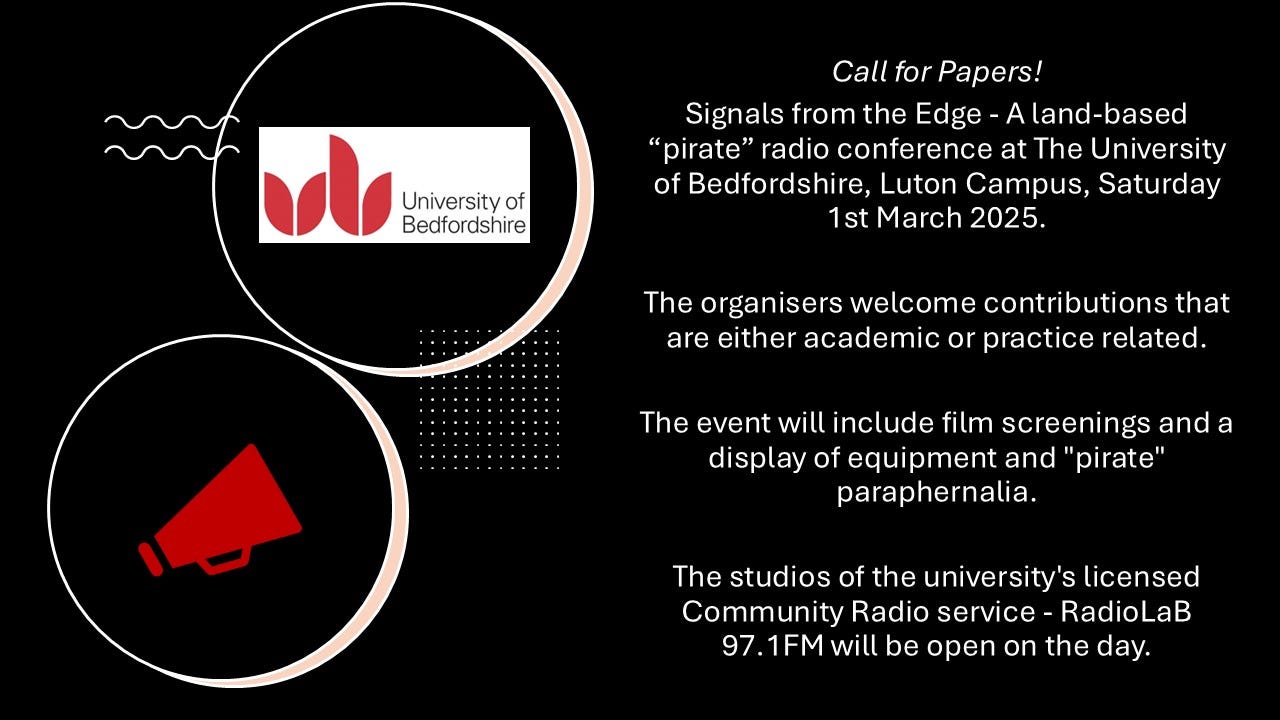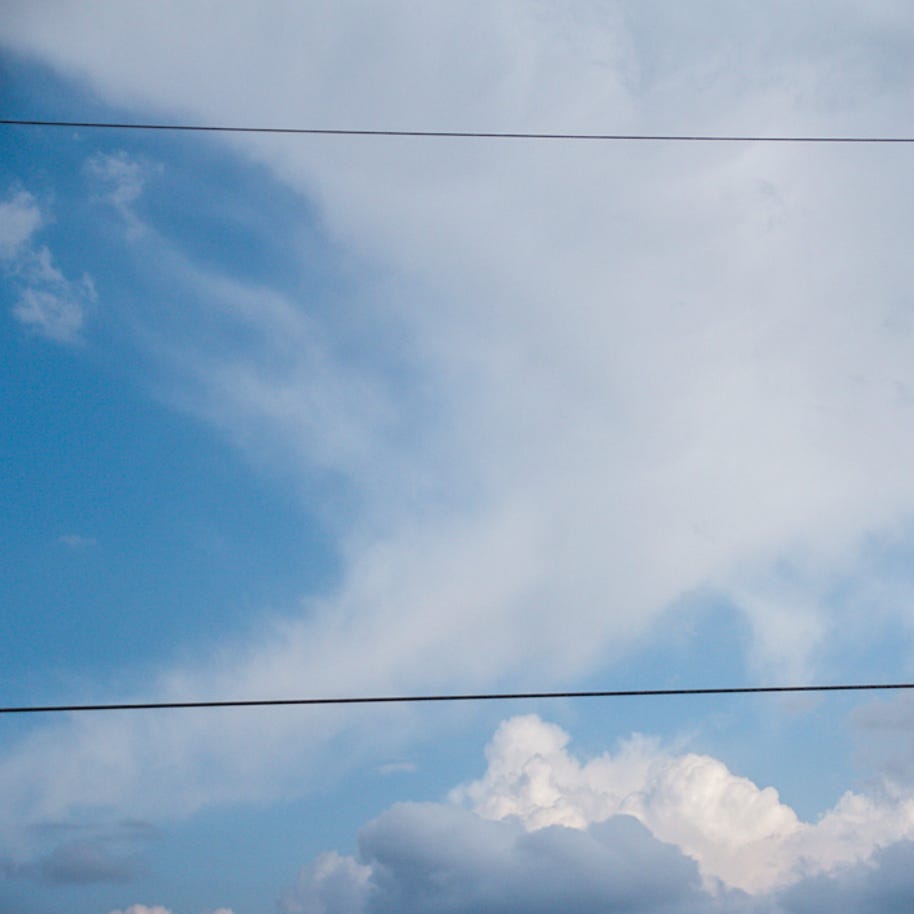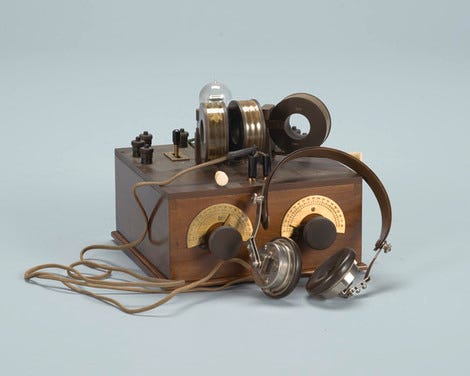This Week in Radio Art: The most famous broadcast signal intrusion
The Max Headroom mask-wearing 'D.B. Cooper of media hacking' has never been identified. Plus, Chris Burden's commercials, and interrupting this year's World Series.
A broadcast signal intrusion “is the hijacking of broadcast signals of radio, television stations, cable television broadcast feeds or satellite signals without permission or licence,” according to Wikipedia, and this year, on Nov. 22, marked the 37th anniversary of what may be the most famous such incident. Ars Technica called the still-unknown perpetrator(s) “the D.B. Cooper of media hacking.” No one still knows who donned a Max Headroom mask and hijacked the microwave frequency studio-to-transmitter links on two different Chicago television stations that night, interrupting a local commercial sports report, and an episode of “Dr. Who” on the public broadcasting station. The clips of the intrusions are below.
The story would be rich enough with an unknown pirate, but wearing this media mask and taking the persona of the fictional faux-talking head, "the first computer-generated TV presenter," adds a more meta reading of the incident. Max Headroom is a fictional character, who made his debut two years before with a radio-oriented back story. Headroom began on British TV as journalist Edison Carter (played by Matt Frewer), a rebel journalist, “fleeing enemies into a parking garage, crashing his motorcycle through the entrance barrier reading ‘Max. headroom 2.3 metres’ …. [then] an AI program based on his mind is created. The AI develops a personality identified as ‘Max Headroom,’ and becomes a TV host who exists only on broadcast signals and computer systems.”
Somehow, two years later, this anti-capitalist spewing non-conformist talking head was a pop culture cause célèbre selling soda on Coke commercials and hosting an American television series. The author George R.R. Martin (“Game of Thrones”) wrote a Christmas episode of Headroom’s American television show, and the fictional character starred in an Art of Noise video.
So in 1987 around the time of the broadcast signal intrusion in Chicago, Max Headroom mania was at its peak. The first interruption came on WGN-TV’s local newscast, during a sports report. The "pirate" transmission of a Max Headroom-like figure spouting dada gibberish lasted for less than a minute, and was ended by station personnel switching to an alternate transmitter. Two hours later the Chicago PBS affiliate WTTW's "Doctor Who" transmission got a longer visit from, presumably, the same Max Headroom. The national and local media made these reports:
Tech writer and editor Alex Pasternack said on WBUR’s “Endless Thread,” “The signal intruders may not have had enough time to say everything they wanted to. But I think my sense is that like they were performing, they were doing something that was that was meant to be, in some ways, a work of art. And in effect, a protest of the corporate media environment. You know, I think that there's there's something poetic about that. There's a certain delectability in the mystery of all of it.” No one of course knows exactly what their intent was, as they have never been caught, and remain, like D.B. Cooper, legends in a myth.
The technical expertise to pull off the intrusion and the comment that they, "made a giant masterpiece for all the greatest world newspaper nerds" — a reference to WGN's call sign, which stands for "World's Greatest Newspaper” — led authorities and internet sleuths to deduce a former employee could be involved. There are two people in the second video, and maybe someone running the camera. But no one knows much of anything for sure about this mysterious transmission.
Usually, there is a political or personal motive around broadcast signal intrusions. The year before, for instance, someone calling themselves “Captain Midnight” took over a Home Box Office cable broadcast of “The Falcon and the Snowman.” The man, who turned out to be John R. MacDougall of Ocala, Florida, took over HBO’s signal for nearly five minutes, and threatened to hijack the signals of Showtime and The Movie Channel. He said he was frustrated with HBO's service rates that were hurting his business selling satellite dishes. MacDougall was able to take over HBO’s satellite signal because he had to take a second job, working as master control operator at a satellite teleport company. Captain Midnight got caught because someone heard him talking about the pirating at a rest stop along I-75 in Florida, and they called authorities with the story. MacDougall was charged with transmitting without a radio license in violation of 47 U.S.C. § 301 and he pled guilty and was fined $5,000 and served a year of probation. More often broadcast signal intrusions are common during wartime, or have political motives, such as the 2006 hijacking of the Babylon, New York, FM radio station WBAB for about 90 seconds with a white supremacist country song, or when an employee of the Christian Broadcasting Network interrupted adult content on The Playboy Channel in 1987 with the Bible verse, "Thus sayeth the Lord thy God: Remember the Sabbath and keep it holy. Repent, the kingdom of Heaven is at hand."
In the early 1970s, artist Chris Burden created perhaps the most well-known broadcast signal intrusion art works.
Wikipedia describes his 1972 “TV Hijack” work, “wherein, during a live television interview to which he had brought his own camera crew, he held interviewer Phyllis Lutjeans at knifepoint and threatened to kill her if the station stopped live transmission (when asked about the incident in 2015, Lutjeans stated that Burden was a 'gentle soul', that she knew it was an art piece, and that the incident did not damage their pre-existing friendship); to conclude the piece, he demanded to be given the station's recording of the incident, which he then destroyed.”
From 1973-1977 Burden made “The TV Commercials,” including buying a month of late-night commercial time on a TV station in Los Angeles, airing a 10-second film clip of “Through the Night Softly,” a performance where Burden, clad only in bikini underwear, crawls across a parking lot full of broken glass with his hands behind his back. Burden wrote, "During the early seventies I conceived a way to break the omnipotent stranglehold of the airwaves that broadcast television had. The solution was to simply purchase commercial advertising time and have the stations play my tapes along with their other commercials." Paying for a broadcast signal intrusion is still a broadcast signal intrusion in the art world.
Doug Irwin, the regional engineering lead for iHeartMedia Los Angeles, which owns KLAC-AM wrote to Radio World magazine recently, to clarify what happened during a broadcast signal intrusion before the broadcast of game five of this year’s World Series between the Los Angeles Dodgers and New York Yankees.
“What happened is that our transmitter site was broken in to, on this of all days, and essentially “vandalized.” The intention of the perpetrators (as all indications are there were two people) was criminal in nature, though the one perpetrator I did speak with before his subsequent arrest by the LA police department tried to explain to me that he has been hearing ‘tones’ in his head for several years, which he claims are caused by RF radiation at 13.56 MHz. He recognized our towers are some sort of radio source and said he was trying to turn it off in order to see if the tones would go away. This is the story he also gave to the police.
What he (and I believe) an accomplice were able to achieve was the detuning of the phasor, the common point matching networks and diplexing filters. Fortunately, the detuning of these various controls was not enough to knock out our BE AM6 transmitter; the VSWR (Voltage Standing Wave Ratio) was vastly increased, as one would expect, and thus the transmitter folded back its power out to compensate. The power was rolled back to about kilowatt (into our non-d tower).”
Radio engineer Burt Weiner arrived at the transmitter site soon after the incident, and remembers, “We discovered that all of the phasor control ‘crank counters’ had been turned to ‘zero.’ All of the variable/adjustable branches in the Phasor are by way of Vacuum Variable capacitors and the inductors are adjusted only by way of bolted clamps.” With only four hours until the game started, they decided to fix things afterwards, and broadcast the game at only 1 kw. The game ended after midnight, and by 3 a.m. the WLAC was back to full power.
The 13.56 MHz frequency is part of the high-frequency (HF) radio spectrum, far apart from AM or FM radio signals, and is used in the U.S. for commercial and industrial uses. Wikipedia explains, “radio waves with frequency between 3 and 30 megahertz (MHz) [are] also known as the decameter band or decameter wave as its wavelengths range from one to ten decameters (ten to one hundred meters).”
The HF 13.56 MHz frequency is often used for radio frequency identification (RFID) for inventory management and asset tracking, but also by devices such as Apple AirTags to help you find lost luggage. Near Field Communications is a sub-set of RFID, operating in the high frequency band with short-range "wireless communication technology that enables data exchange between two devices when they’re in close proximity—typically less than 10 centimeters apart.” Stripe payment devices are one example.
There is little direct scholarship available about hearing tones in your head from this frequency. But there is some related research.
One study of RFID readers emitting signals at 13.56 MHz found that the use of hearing aids increased effects of 13.56 MHz EMF exposure.
Another study, on “The Effects of Non-Invasive Radiofrequency Treatment and Hyperthermia on Malignant and Nonmalignant Cells” showed some hopeful results for non-invasive radiofrequency (RF) treatment at 13.56 MHz. That study said:
“RF treatment caused declines in cancer cell viability and proliferation. RF treatment also affected mitochondrial function in cancer cells more than HT treatment did and, unlike HT treatment, was followed by the elevation of autophagosomes in the cytoplasm of cancer cells. Importantly, the effects of RF treatment were negligible in nonmalignant cells. Conclusion: The obtained data indicate that the effects of RF treatment are specific to cancer cells and are not limited to its hyperthermic property.”
The new FCC censor
Many post-election changes to U.S. communication law are on the way. Radio World reports that Brendan Carr, the conservative Federal Communications Commission member, is being nominated, as expected, to take over as chair of the FCC from Democrat Jessica Rosenworcel. His version of a broadcast signal intrusion is to censor what others want to put on the airwaves.
Carr wrote a chapter for the conservative Heritage Foundation Project 2025 and opposes net neutrality rules and other broadband regulations. Days before the election, Carr alleged that NBC putting Democrat presidential candidate Kamala Harris on “Saturday Night Live” was, "a clear and blatant effort to evade the FCC's Equal Time rule," and said that the FCC should consider issuing penalties. Inside Radio reports that, “Carr also opposed the FCC’s recent ruling to partially reverse a 2020 decision to eliminate the simulcast rule for FMs while leaving it alone for AMs.” And Carr also wants to crack down on social media websites for alleged anti-conservative bias and expand the list of companies which are deemed to pose a security risk to the U.S. Ted Hearn, Policyband publisher and former VP of industry association ACA Connects, said he believes it’s “entirely possible” current FCC chair Rosenworcel might try to work on the 60-day phone unlocking mandate, tweak pole attachment rules, or “ban restrictive clauses in cable programming contracts…. But she might find that pointless because some or all of it could be reversed by a Carr-led FCC or voided under the Congressional Review Act.”
During the campaign, Trump also called for the FCC to revoke the licenses of the ABC and NBC television networks. But ABC News is reporting that Chinese cyber spies hacked into the main cellphone used by Donald Trump's lead criminal defense attorney Todd Blanche during the election campaign. ABC reports, “The FBI determined that Blanche's communications with family and friends were compromised, and investigators are still trying to determine if communications with more sensitive contacts were impacted.”
Ahmed Baba wrote about this issue:
“After I called out Brendan Carr’s Project 2025 ties on Twitter, Carr replied to my post at 2:20 a.m., saying, ‘I’m sorry this happened to you.’ The next morning, because I’m not up at 2 a.m. fighting with people on the internet, I replied with a question:
‘While I have you here, will you definitively rule out targeting the broadcast licenses of news networks Trump disagrees with? He’s called on the licenses of multiple networks to be revoked. You claim to be a free speech champion, so this answer should be a no-brainer.’
I’ve yet to get a response to my question.”
Trump said when he nominated him that “Commissioner Carr is a warrior for Free Speech, and has fought against the regulatory Lawfare that has stifled Americans’ Freedoms, and held back our Economy,” Mike Masnick at TechDirt reports, “However, this is all projection, as with so much in the upcoming Trump administration. In reality, Brendan Carr may be the biggest threat to free speech in our government in a long while. And he’s not being shy about it.” Carr, for instance, is currently pretending that he supports pulling the licenses of broadcast networks who put on guests he disagrees with. Carr, specifically, says he supports taking NBC’s license because of the Harris “Saturday Night Live” appearance during the recent election. But Masnick notes, “NBC has no broadcast license to pull. Broadcast licenses are held by local affiliates who contract with NBC. NBC does own twelve affiliates, but the vast majority of NBC affiliates (223 of them) are not owned by NBC. Carr knows this. But he’s seen Donald Trump argue that NBC, CBS, and ABC should all have their (non-existent) licenses pulled at various times, and so he’s claiming the same thing.”
Carr is also claiming domain over Section 230 is a section of the update Communications Act of 1934 for more censorship, even though, Masnick writes, “Congress was pretty clear when it passed Section 230 that its direct intent was that the FCC not have authority over internet companies. Indeed, when Rep. Chris Cox introduced what became Section 230, it explicitly called out that the FCC shall not be authorized to regulate internet content services:
Declares that nothing in this Act shall be construed to authorize Federal Communications Commission regulation of the content of such services.“
But Carr’s actions to quash a group from giving its opinion on the veracity of news stories on the internet, contradict the law. Carr is also using CBS’ refusal to release the transcript of its full “60 Minutes” interview with Vice President Kamala Harris to threaten a government review of parent company Paramount Global’s proposed merger with Skydance, according to the New York Post. Carr is also in favor of banning Tik Tok, where another free speech argument could be made. And, USA Today reports, “Carr wants to support Musk's Starlink, a satellite constellation that provides internet coverage to over 100 countries. StarLink is a subsidiary of aerospace company SpaceX.” And “[Rep.] Marjorie Taylor Greene plans to team up with Musk to defund NPR,” Salon reports, quoting Greene saying, "We'll be looking at everything from government-funded media programs like NPR that spread nothing but Democrat propaganda...all kinds of programs that don't help the American people."
Until Jan. 20, Carr’s talk is just that, and we will all see how successful the fascist regime in the U.S. is at getting policy enacted. No matter what, though, radio policy in the United States is about to change, with government censorship the new broadcast signal intrusion.
Substack radio stories
Two great music writers have transmission stories to tell this week:
From Gina Arnold’s “Bring Me Giants” Substack:
“But here’s the thing. Even when they play songs I don’t like – and maybe especially when they do that -- I love listening to the radio. I love the surprises and the shoutouts and the weather report, even when it’s for Seattle. I love the d-jays evincing actual personalities and showing off their bizarre taste, and the nagging sense, left over from childhood, that there are little tiny people inside the radio who are making it all happen. It was a pleasure of my youth and now I am experiencing it again. The arrival of KEXP in Oakland has felt like a secret handshake or something, a sign that the robot army isn’t in entirely in control of us.”
From Jay Babcock’s “Landline” Substack:
“Having been born in 1970, there’s a triple nostalgic pull for me listening in this way because I remember hearing many of these songs the first time around… on AM radio… in a car. For me, this is these songs’ native habitat, and I suppose, in some weirdo way, I am happy to return there occasionally and find everyone still doing their thing. And despite the inevitable drivel and pap, I’m still hearing new, fascinating nuggets that reframe my understanding of this culture’s past, and thus, the present.”
Transmission Art performances, exhibitions, opportunities, and open calls are below.“On Standby” from the data-sonification group Loud Numbers (Duncan Geere and Miriam Quick), is “a piece of sound art designed to be listened to while sleeping. It’s based on data collected by seven different people in Malmö, Sweden. Each of those people used a smart plug to collect data on the energy consumption of a device in their home over the course of a single night, the night of 25th August 2024. The music plays out over the same timescale - one minute of data from 25th August takes one minute to play back. The whole dataset takes 10 hours and 40 minutes to run through. You’ll hear a unique sound every time a different device consumes half a watt hour of energy - about the same amount it takes to bring a teaspoon of water to boiling point. Many devices on standby don’t consume much energy, but they are always switched on, so this energy use stacks up over time.”
Upcoming Broadcasts
2024-11-29 @ 10pm Sweden time (UTC+1): NGBG Radio
2024-11-29 @ 10pm UK time (UTC): Soundart Radio
2024-12-02 @ 10pm Europe time (UTC+1): YouTube Live
2024-12-03 @ 10pm Chicago time (UTC-5): YouTube Live
2024-12-05 @ 10pm Beijing time (UTC+8): YouTube Live
Leipzig installations
Curator Sybille Neumeyer has put together “Teleconnections” in Leipzig with artists Tekla Aslanishvili, Tega Brain and Sam Lavigne, Simone Fehlinger, Mia Heidler, Sonja Hornung and Daniele Tognozzi, João Enxuto and Erica Love, Sybille Neumeyer, Oliver Ressler, Stefania Smolkina, and open-weather (Soph Dyer and Sasha Engelmann) with a ““Radical Offset” artist talk with Brain and Lavigne on Nov. 29.
Transmission Japan
SCAI The Bathhouse, a contemporary art gallery located in Yanaka, Japan, hosts “__Transmission” from Tony Oursler through Dec. 21. Oursler is a transmission art legend, with the gallery crowing he is, “a multimedia artist who explores the psychological effects of technology and media on human perception, often incorporating projection into his research-based projects in worldwide galleries, museums, and public spaces…. The exhibition “__Transmission” showcases the breadth of his career, from the early signature piece to his latest work, being shown for the first time.” The new work, “‘Wikkae’ (2024) presents a new series of stock characters, specifically a new-age practitioner, brought to life through a digital lens that animates the face. This small figure floats above an imaginary landscape that suggests a volcanic ruin, hinting at a renewed interest in pseudoscientific systems and the occult as a means of rejecting technology. This theme is further explored with Eu/An (2024), a colourful wall screen in the form of a crystaline structure. Combining digital screens and polychromed mirrors, this piece implies a convergence of technology and nature, where New Age crystal power and high-tech nanotechnology meet, identifying our current moment as one of re-enchantment.”
Supernatural sounds
Radio artist Scanner and Mike Kelley have a show at Centre Pompidou in Paris next month. Scanner writes, "This is an unusual installation in my catalogue of works since it does not use any instrument or traditional sound. This installation is the result of a series of recordings of visual and sound environments made in different districts of Paris. These recordings, made in places that are attributed with supposedly supernatural characteristics, are presented as documentary sources, while images recorded in a club full of dancing people are projected in the museum space. In this work, sound experimentation is combined with an application of the method that William S. Burroughs calls ‘The Control Machine,’ in his text ‘The Invisible Generation’ (1966)."
The 29th edition of the Phonurgia Nova Awards took place for the first time in Marseille Nov. 13-16, with 336 productions from 27 countries debated for three days by the jury in open court. Among the winners, for “Sound Art Award” was Antje Vowinckel for “Opdoppling.” “The performer breaks down various frequencies, from phones or even Bluetooth boxes, that colonize our sound space.” (self-production, Germany, 41 mins)
Pirate radio papers
“Signals from the Edge - A land-based pirate radio conference” at The University of Bedfordshire, Luton Campus on March 1, 2025, out on by the MeCCSA Radio Studies Network, is calling for papers:
“Unlicensed broadcasting dates back to at least the 1930s and has often impacted the evolution of mainstream broadcasting. For example, land-based pirate broadcasting helped make the case for UK local commercial radio in the 1970s and forced the introduction of commercial and community radio in Ireland during the early 1980s. The more recent introduction of UK community radio was also aided by the existence of numerous unlicensed broadcasters during the 1990s and early 2000s.
This one-day conference will focus on land-based unlicenced radio broadcasting, in the UK, and Ireland, but also globally. We plan that the event will lead to a publication and to similar events in future.
Conference themes will include, but are not limited to, presentations that examine
• The current situation of land-based pirate radio,
• its history and influence
• the sociology of pirate radio
• the technologies used
• the politics and regulation of radio broadcasting.
The organisers welcome contributions that are either academic or practice related.
The event will include film screenings and a display of equipment and "pirate" paraphernalia.
The studios of the university's licensed Community Radio service - RadioLaB 97.1FM will also be open on the day.
The organisers invite proposals for 15-minute presentations from @followers practitioners, academics, independent researchers, archivists, postgraduate students, and broadcasters. We are open to critical perspectives and encourage comparative case studies.
We are also happy to receive proposed panels comprising no more than four papers each but reserve the right to organise these as we think best.
Submitting a proposal (This bit is very important!)
Please use the following format for proposals:
• Name, affiliation, and email
• Title of paper or presentation
• 200 word abstract or summary of your paper or presentation
• 100 word biography
Send proposals as a Word doc by email to: Dr Lawrie Hallett
lawrie.hallett@beds.ac.uk
Deadline for proposals: midnight Monday 16th December 2024
Confirmation of accepted presentations will be by Friday the 10th of January 2024.
Details on how to register for the Conference and confirmation of ticket prices (-approximately UK £55.00 including lunch and refreshments) will follow. Registration will be via the University of Bedfordshire.
The organisers are happy to discuss proposals prior to submission – please contact either Lawrie Hallett (lawrie.hallett@beds.ac.uk) or Mark Wakely (markwakely@1386audio.com)”
Changing radio call
Call for Papers: “Cog in a wheel? Radio and Sound in the Changing Mediascape.” For the ECREA Radio and Sound Section September 7-10, 2025.
“This conference aims to examine the past, present, and evolving role of radio around the world within a dynamic global media landscape. We will highlight the transformation of radio from a static entity to an adaptive component of the larger media ecosystem, continually reshaping itself in response to socio-political, economic, and technological changes. In the early 20th century, radio played an important role in the establishment and development of nation-states — especially militarily, economically, politically, and linguistically. Today, it is ubiquitous in various forms, multi-faceted, and present throughout the world. With the advent of artificial intelligence and non-human presenters, along with rising public mistrust and the prevalence of disinformation, radio faces new pressures to evolve. Nevertheless, radio endures as a critical medium, especially during global conflicts, where it serves as a source or way of communication for the different parties to the conflict as well as for the diaspora communities.”
Open waves
Radio Tsonami invites you to participate in the radio broadcasts of the XVIII International Sound Art Tsonami Festival 2025, through an open call from November 25 to December 11, 2024.
“Under the theme of Atmosférica, this version of Tsonami Festival is interwoven with the fascination for natural phenomena and its observation at a physical and symbolic level. The encounter with phenomena from Earth’s atmosphere, the sound of storms, the magnetosphere and its relationship with the sun and the universe, led us to think about other ways of relating to the environment, and how the need to interpret and make sense of of it all is deeply human.
We invite you to observe, investigate and explore natural phenomena from the perspective of sound practices, approaching this relationship from points of view that may not necessarily be hegemonic or scientific, integrating diverse environmental readings and researching the invisible forces within a planetary system in crisis.
Participate by sending radio works, either created especially for Tsonami Festival 2024 or have been recently created. That are related to large-scale events, systems and cycles such as climate, winds, tides, radiation from space, natural and artificial radio waves, systems of imperceptible forces, and their relationship with our ways of thinking and relating with the planet. Duration of works: minimum 15 mins. – maximum 60 mins. Free format
To participate you must read the following rules: https://forms.gle/z7NeN3hxcLbWQHk27”
Enter radio dramas here
The UK International Radio Drama Festival began taking submissions on Nov. 18. “We’re looking for applications from national broadcasters and independent producers in any language and from any country. And it’s free to apply! The countdown is on,” they announced last week.
Find out more here.
Creative radio building
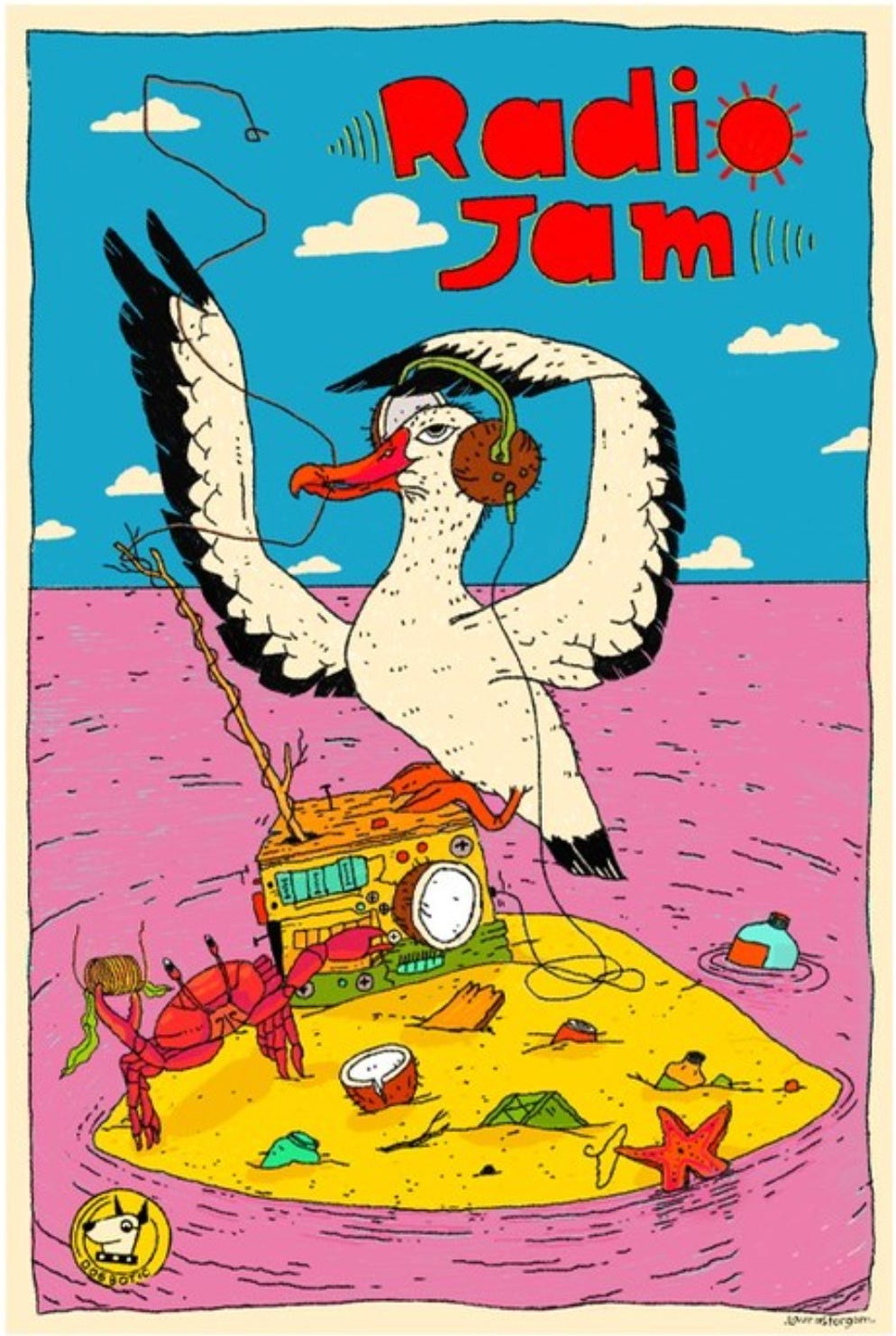
Dogbotic just added “Radio Jam,” a ten-week virtual workshop about creative radio building. They write, “Radio Jam is here for people that have always wondered how we can magically transmit information through the air. It will give you a new way to think about this technology, to understand how and why it works through hands-on experiments and tinkering.” The workshop is from February 25-April 15, 2025 at 4:30-6:30 p.m. PST, or 7:30-9:30 p.m. EST (-5 UTC). Instructor: @kerkirajss.
The Best Tabletop Radios?
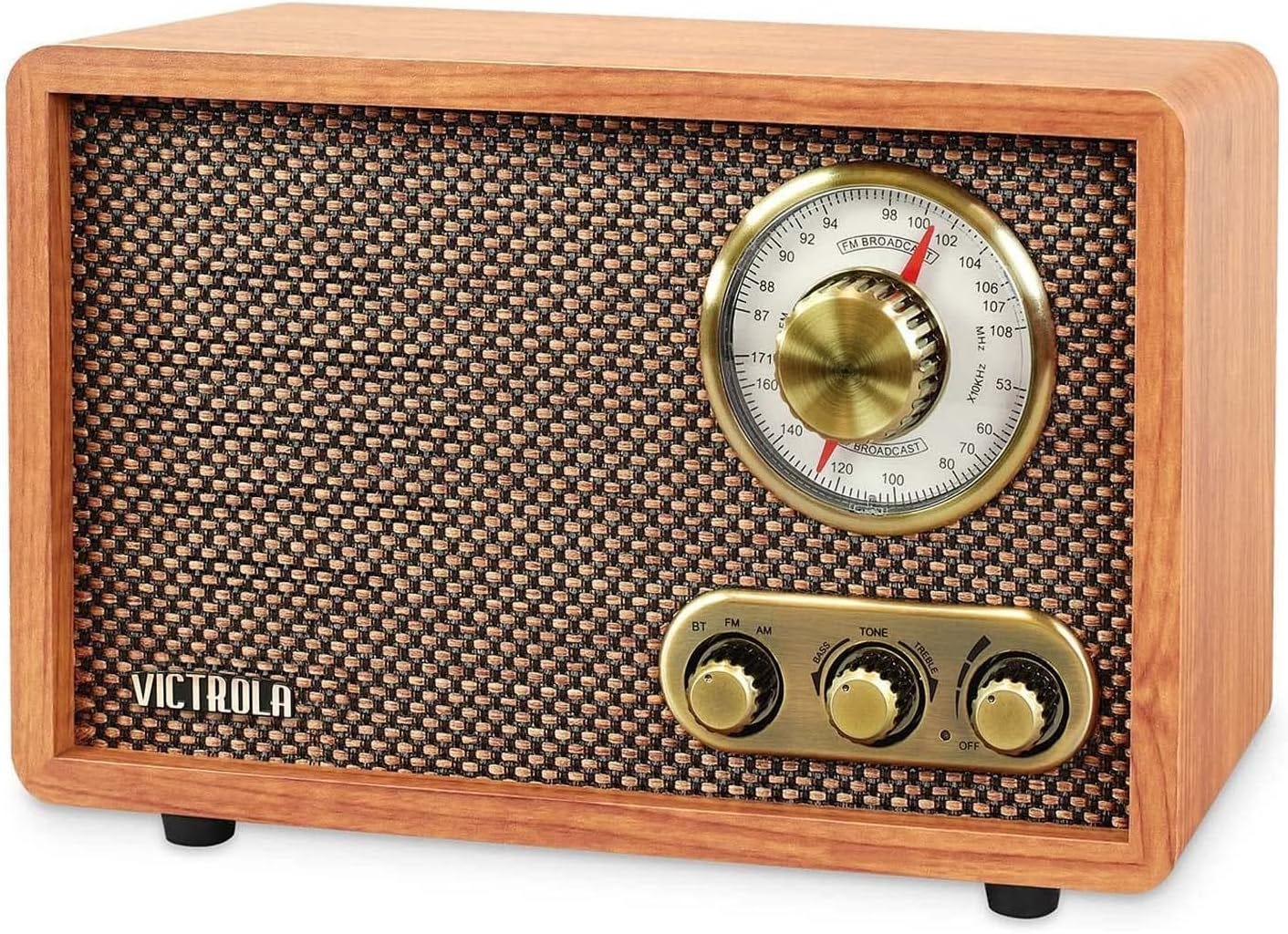
Before the holidays, this column each week will listen to some radio voices about receiver choices. The New York Times’ Wirecutter section reviewed posh tabletop radios recently, that began with a warning: “Sound quality and reception are important, but our research has found that radio owners and shoppers primarily want something stylish that will look great in their home.” At the very end of the story, they do get around to rating radios for reception, not just aesthetics:
Crosley Tribute: In our tests, this tiny radio wasn’t bad for the price, but it relies on a USB power cord that extends only 21 inches, with no power base included. You’re better off with the Studebaker SB2000, which sells for less and got better reception in our tests.
Sangean WR-2: Although the WR-2 represents a functional upgrade over the WR-11SE—in its digital tuner, station presets, and front-panel headphone jack, just to name a few features—we prefer the WR-50P if you’re shopping for a model with a digital tuner and station presets.
Sangean WR-12: The WR-12 is simply a larger WR-11SE with stereo speakers. Two speakers packed into a cabinet that small can’t give you much sonic impact or channel separation, though, so if you’re looking for stereo, you’d be better served by the WR-50P.
Tivoli Model One: Although there’s a lot to love about the Tivoli Model One, particularly its iconic design, the Sangean radios offer better build quality and features. We also found the Model One’s imprecise radial tuning dial a bit frustrating. Tuning to 95.1 FM, a popular classic-rock station in our test location, required us to situate the dial between 94 and 95. Likewise, 95.5 FM, another local classic-rock station, was located at precisely 95 on this Tivoli model’s dial. The Sangean radios were more precise and cost less.
Tivoli Model One BT: We experienced the same tuning issues on the Bluetooth version of the Model One. Its indicator light was constantly flickering, highlighting its own tuning difficulties. It also performed the worst in all of our channel testing.Victrola Willow: This radio, surprisingly, performed the best of all in our FM testing, thanks to its attached external antenna. However, its tuning dial was extremely imprecise and seemed to get worse as we continued up the dial. For instance, 89.5 FM, NPR’s San Diego station, was closer to 89 on the dial, while 100.7 FM, a popular music station, landed on nearly 102.
Donald Drumpf Theatre: Television Oligarchy or a Series of Distractions
This week’s episode of the radio theatre show “Donald Drumpf Theatre” is called "Television Oligarchy or a Series of Distractions." The fascist president-elect loses his consigliere this week while continuing to keep the cameras rolling. Opening theme includes clips from Rod Serling; Bill Cosby; Jon Stewart; Larys Strong; Andrew Weissmann; Rudy Giuliani; Donald Drumpf; Eric Cartman; Richard Nixon; and Kent Brockman. Thanks for the songs from Golden Earring ("Twilight Zone"), Black Flag (“TV Party”), and Talking Heads (“Television Man”). Clips and excerpts from Victor Laszlo, Louis Renault, and Rick Blaine from “Casablanca;” Bernie Sanders; Michael Ian Black; J.L. Cauvin; Desi Lydic; Amber Ruffin; Kara Swisher; Nicolle Wallace; Seth Meyers; Donald Drumpf; Stephen Colbert; Randy Savage; Jimmy Kimmel; Grace Kuhlenschmidt; Roy Wood, Jr.; Jenny Hagel; John Berman; and Lawrence O'Donnell. Episode 214.
Radio news this week:
Respond
Send items, press releases, announcements, letters to the editor, angry responses, gentle praise, images, sound, and more for this column to:
tomroeradio@proton.me
Everyone is also encouraged to make comments on this site. Interact! Please get in touch if you feel something is incorrect. If you like this column, please subscribe. It is free, or there is a special offer right now: if you sign up as a Founding Member for $51 or more, you will get a lifetime subscription. You won’t ever have to pay again. Please consider getting this new multi-media project started with a lifetime subscription. Thank you — Tom Roe.
Thank you!
I would like to thank you all for subscribing, and listening each week. It is an honor for me to have you tuning in “Turn On The News.” There are so many great writers reading here, and so many wonderful souls, and a bunch of folks I do not know. Thank you all for being here, it is inspirational, and wondrous.
Hopefully, I don’t overwhelm you with messages. Currently there are three emails going out, and you can increase or decrease that at your Substack settings. The emails are:
Monday: “This Week in the Hudson Valley” with events to attend, rallies to support, issues to address, sounds to hear, and images to view.
Wednesday: “Donald Drumpf Theatre” is a half-hour radio theatre show since 2015 chronicling the hilarious misadventures of a fictional American president. This is also subscribable audio, or what some call a “podcast.”
Friday: “This Week in Radio Art” highlights interesting broadcasts, trends, pirate signals, open calls, experiments, studies, and frequency improvisations.
When subscribing, please only choose the sections that apply to you. You can receive all three of those emails, or opt-out of getting any of them. Either way, you can access all of the pages at “Turn On The News.” Depending on where you live you might not need Hudson Valley news emails, or you might not be interested in radio art alerts. It is very easy to turn off the Substack emails and receive fewer or none of them. You can turn off the multiple notifications too. And message me if you need help.
SPECIAL OFFER — through Dec. 31!
You could also become a paid subscriber if you wanted. For a limited time — just through the end of the year — anyone who signs up right now as a Founding Member for the $51 subscription (or higher) will get a lifetime subscription. That means you never have to pay again, and you will always get full access to “Turn On The News.” The site is already growing with guest columns, links to other relevant Substacks, and all sorts of original sounds and stories.
Please consider helping to launch a full-fledged publication covering both Hudson Valley activism, and international radio art. A site with news and cultural coverage from Troy to Westchester County, and pirate radio reporting from around the world, with all sorts of experimental music too. The idea here is to build a useful source of art and activism in the Hudson Valley.
Please become a paid subscriber if you can, or keep reading all the articles here for free! This offer lasts through Dec. 31. Thanks again for turning on the news here.




